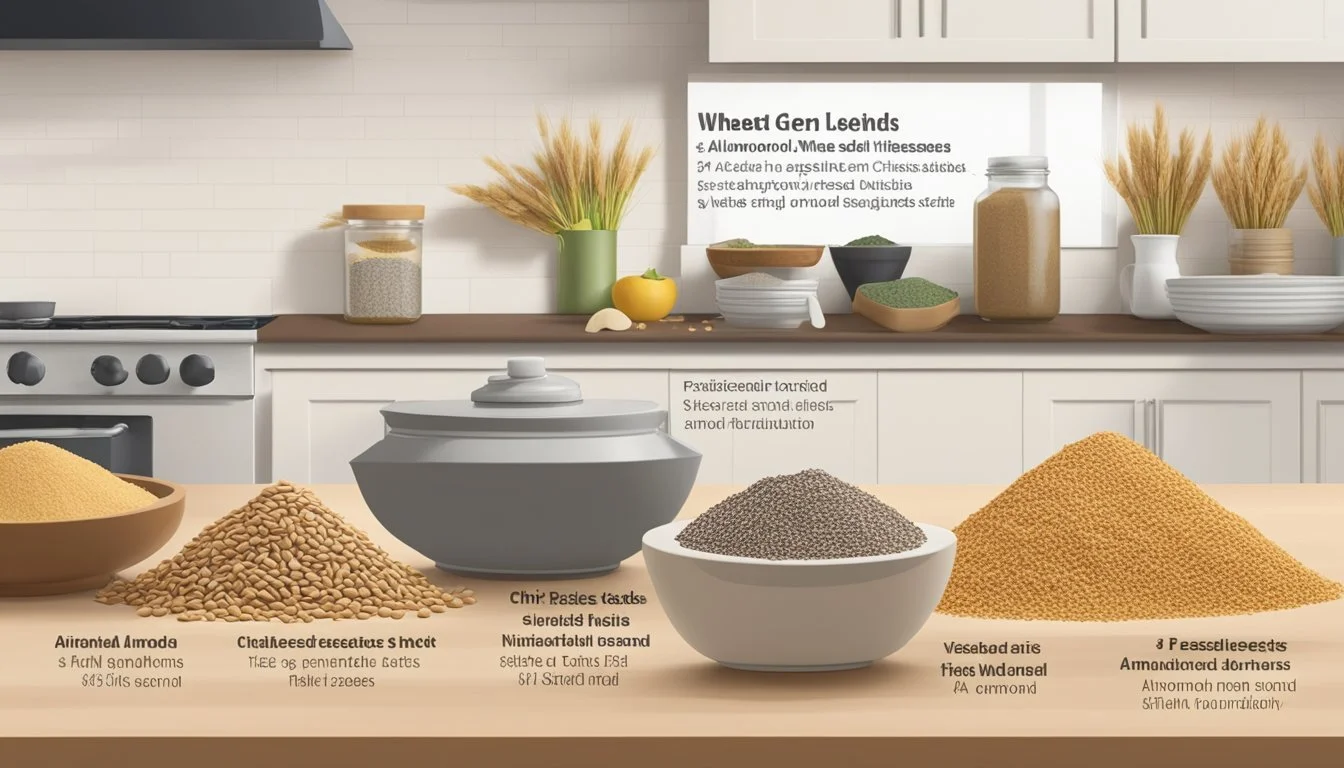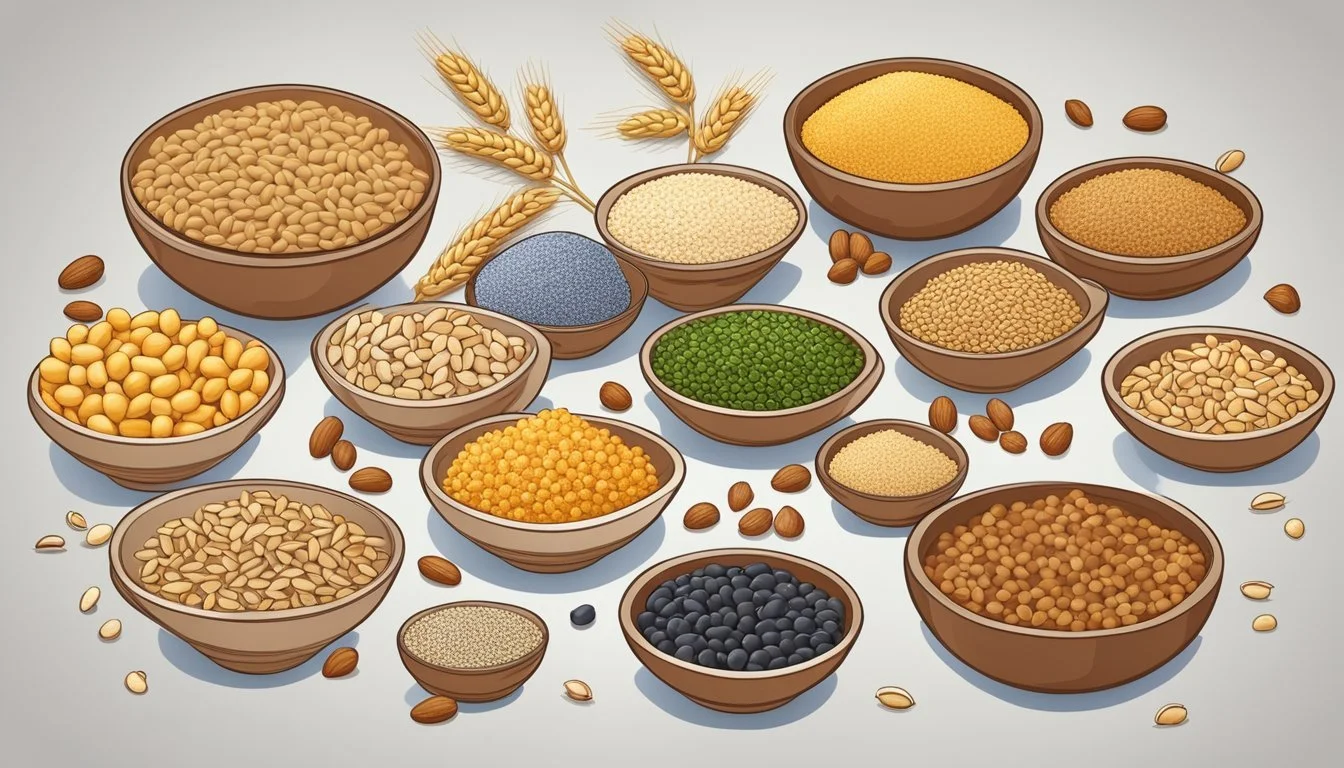Wheat Germ Substitutes
Top Alternatives for Your Recipes
Wheat germ, the nutrient-rich core of a wheat kernel, is often used in recipes to boost the nutritional profile with added vitamins, minerals, and fiber. Yet, there are many instances where finding a suitable substitute becomes necessary, especially for those adhering to gluten-free diets. For those looking to replace wheat germ, options like rice bran, ground flaxseeds, and chia seeds can serve as effective alternatives, providing similar nutritional benefits without gluten.
Ground sunflower seeds stand out as another excellent substitute. These seeds can be swapped in equal amounts for wheat germ, offering a similar texture while contributing essential nutrients such as vitamin E and magnesium. Additionally, combining whole wheat flour with a touch of honey can serve as a partial replacement, particularly in baking recipes, adding natural sweetness and fiber.
Exploring these substitutes can open up new possibilities for those with specific dietary needs or those just looking to innovate in their cooking and baking routines. Whether it's rice bran's versatility or flaxseeds' rich nutrient profile, replacing wheat germ doesn't mean compromising on health benefits or flavor.
Understanding Wheat Germ
Wheat germ is a nutrient-dense part of the wheat kernel that is removed when processing refined flour. Its rich nutritional profile and versatile culinary uses make it a valuable ingredient.
Role in Nutrition
Wheat germ is renowned for its high nutritional benefits. It contains essential vitamins such as B vitamins and vitamin E, which support energy metabolism and act as powerful antioxidants.
It is also a good source of protein, providing essential amino acids necessary for bodily functions. The presence of fiber aids in digestive health and contributes to a feeling of fullness. Additionally, wheat germ is rich in minerals like iron and magnesium, important for oxygen transport and muscle function.
Its considerable fatty acids content, including omega-3s, contribute to heart health. Together, these components make wheat germ a small but mighty addition to a balanced diet.
Culinary Uses of Wheat Germ
In the kitchen, wheat germ's nutty taste and flavor add depth to a variety of dishes. It is often used in baking, enhancing the nutritional value and flavor profile of bread and other baked goods.
Wheat germ can be sprinkled over cereals, yogurt, or smoothies as a topping. It can also be incorporated into recipes for cookies, pancakes, and granola bars. Its nutty flavor complements savory dishes as well, such as meatloaf or casseroles.
By integrating wheat germ into everyday recipes, cooks can easily boost the nutritional content of their meals while enjoying its unique taste.
Common Wheat Germ Substitutes
Several alternatives offer unique benefits, ranging from rich nutrient profiles to gluten-free options. These substitutes ensure you don't compromise the texture, flavor, or health benefits in your recipes.
Flaxseed as a Substitute
Flax meal, made from ground flax seeds, is a robust substitute for wheat germ. Rich in omega-3 fatty acids and high in fiber, flaxseed enhances the nutritional profile of any dish.
Ground flaxseed provides a chewy texture, making it ideal for baking muffins, bread, and cookies. Its nutty flavor integrates well into various recipes, offering both taste and health benefits.
Bran Varieties
Rice bran and oat bran are popular substitutes due to their high fiber content and gluten-free properties. Rice bran is obtained from the outer layer of rice grains and is known for adding a subtle sweetness and richness to baked goods.
Oat bran, another hearty option, brings a mild flavor and a significant nutrient boost. Wheat bran can also be used for those not avoiding gluten, enriching your recipes with added fiber and maintaining a slightly coarse texture.
Sunflower Seeds and Products
Ground sunflower seeds are another versatile, nutritious substitute for wheat germ. Naturally gluten-free, they fit well into various diets.
Sunflower seed flour can be used in baking, adding a mild, nutty flavor to your recipes. These seeds are also a good source of vitamins and minerals, making them a healthy addition.
Nut-Based Substitutes
Almond meal or almond flour serves as a great wheat germ alternative, especially for those seeking a gluten-free option. Almond meal is made from finely ground almonds and adds a subtle, nutty flavor to baked goods.
It’s perfect for recipes that benefit from a slightly coarser texture, like cookies and cakes. High in protein and healthy fats, almond meal enhances both the taste and nutritional value of your recipes.
Other Grain Flours
Whole wheat flour and oatmeal are practical substitutes for wheat germ. Whole wheat flour offers a rich, earthy flavor and significantly boosts fiber content. It can be used in various baked goods, maintaining a similar texture to wheat germ.
Oatmeal can also be ground into a flour-like consistency and used in place of wheat germ. Coconut flour is another alternative, lending a distinct flavor and high fiber content, though it may require adjustments in liquid ratios due to its absorbent nature.
Wheat Germ Substitute in Specific Recipes
Various substitutes can effectively replace wheat germ in different recipes. The choice of substitute often depends on the recipe type, desired flavor, and nutritional value.
Baking Recipes
In baking recipes like muffins, cakes, cookies, and pancakes, replacing wheat germ can retain the chewy texture and enhance the nutritional value. Flax meal is a great alternative, offering a chewy crumb, particularly in muffins. Substitute one cup of wheat germ with one cup of flax meal for a similar texture. Whole wheat flour can also be used, though it may make baked goods denser. For sweetness, adding a small amount of honey alongside whole wheat flour can balance the recipe.
Savory Dishes
For savory recipes such as casseroles, meatballs, and soups, ground substitutes maintain the right consistency without altering the flavor much. Ground sunflower seeds are an excellent option for their subtle, nutty flavor and nutritional benefits. They mix well with other ingredients and offer a similar texture to wheat germ. Rice bran is another choice, providing dietary fiber without affecting taste, perfect for stews and meat mixtures.
Breakfast and Smoothies
In breakfast dishes like granola, yogurt, and oatmeal, as well as smoothies, substitutes for wheat germ should blend easily and maintain a pleasant flavor. Ground flaxseed or rice bran serves well for these, contributing to the nutritional profile. They blend seamlessly with other ingredients, ensuring the consistency remains unchanged. Chia seeds can also be used, offering extra crunch and nutritional value without altering the flavor significantly.
Breads and Toppings
For bread recipes and toppings or coatings on baked goods, texture and binding properties are crucial. Whole wheat flour works well by maintaining the bread’s consistency while adding a hearty flavor. When seeking a crunchy topping for casseroles or baked dishes, ground sunflower seeds provide a similar texture to wheat germ. Breadcrumbs are another option for toppings, providing the required crunchiness without significant flavor deviation.
Nutritional and Health Considerations
When looking for substitutes for wheat germ, it's essential to consider the nutritional value and any dietary restrictions. Many alternatives offer varied health benefits, such as improved heart health and cancer prevention, while catering to gluten-free diets and allergies.
Gluten-Free Alternatives
For those with celiac disease or gluten sensitivities, rice bran is an excellent substitute. It is gluten-free and rich in dietary fiber. Additionally, rice bran provides essential vitamins and minerals, making it a robust nutrient-rich option.
Another alternative is oat bran. It's naturally gluten-free but ensure it is labeled as such, as cross-contamination can occur. Oat bran is high in soluble fiber and can help lower cholesterol, promoting heart health.
Ground flaxseed or flax meal is not only gluten-free but also packed with omega-3 fatty acids, which are beneficial for heart health. Its rich nutrient profile also includes folic acid, calcium, and various vitamins that can aid in overall health.
Allergies and Dietary Restrictions
For those with wheat allergies, oat bran and rice bran are good substitutes. Both are wheat-free and provide essential nutrients like fiber and protein.
Flaxseed meal is also suitable for individuals with specific allergies, including nut allergies, as it is generally considered safe and nutrient-rich.
Chia seeds can be used as a replacement due to their high nutrient content, including omega-3 fatty acids, fiber, and protein, while being hypoallergenic and fitting well into vegan diets.
Whole wheat flour combined with honey can act as a substitute, although it is not suitable for gluten-free diets. This mix provides a nutrient boost similar to wheat germ but requires careful consideration of the user's dietary needs.
Shopping and Storage
When looking for wheat germ substitutes or ensuring that these substitutes remain fresh and usable over time, certain factors like the source and storage methods come into play. This section provides insights into selecting and maintaining wheat germ alternatives for optimum flavor and nutritional benefits.
Finding Substitutes
Health food stores and large supermarkets are prime locations to find wheat germ substitutes. Ingredients like flaxseed meal, rice bran, oat bran, and whole wheat flour are commonly stocked.
Flaxseed meal is particularly noted for its healthy profile, rich in omega-3 fatty acids and fiber. Rice bran and oat bran are excellent substitutes due to their gluten-free nature and similar texture. Whole wheat flour, with its mild flavor and dark color, is a versatile ingredient that can be used in many recipes calling for wheat germ.
Retailers may also offer these substitutes in different sections, such as the baking aisle or health food section. Ensuring that the product is labeled clearly and checking for any added ingredients is crucial to maintaining dietary requirements.
Storing Substitutes for Freshness
Proper storage is essential to maintain the freshness and nutritional quality of wheat germ substitutes. Flaxseed meal and rice bran should be kept in an airtight container and stored in the refrigerator or freezer to extend their shelf life, which is typically around 3-6 months.
Oat bran and whole wheat flour should also be stored in a cool, dark place. Using airtight containers helps in preventing moisture and pests.
For optimal flavor and nutritional benefits, rotate stock and use the oldest products first. Always check for changes in smell, taste, or appearance before using these substitutes to ensure they are still fresh and safe to consume.
Creative Applications and Tips
Exploring wheat germ substitutes can reveal how they enhance both sweet and savory dishes, as well as how they can alter the texture of your culinary creations. From boosting flavors to tweaking consistencies, these tips help you maximize the potential of these alternatives.
Enhancing Sweet and Savory Flavors
Wheat germ substitutes like rice bran, oat bran, and flax meal can elevate the taste profile of many recipes. Rice bran adds a subtly sweet, nutty flavor that is ideal for cookies and muffins. It's gluten-free and enhances nutritional value with dietary fiber.
For a twist in savory dishes, oat bran provides a similar nutty taste and slight crunch, perfect for adding to meatloafs or coating for fried foods. Using flax meal introduces a richness from omega-3 fatty acids, often complementing the natural sweetness of molasses or honey in baking.
Textures in Cooking and Baking
The textures of wheat germ substitutes can vary, creating either a chewy or crunchy consistency. Flax meal, with its fine consistency, can add a chewy texture to batch recipes like muffins and granola bars.
On the other hand, rice bran can mimic the crunchiness of wheat germ, making it suitable for those who prefer a crispier texture in baked goods like cookies. Oat bran offers a nice balance, providing a slight crunch but with enough softness to not overpower the dish. These substitutes not only match but can sometimes enhance the desired consistency in both cooking and baking.







